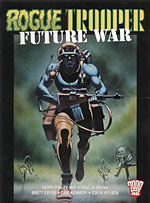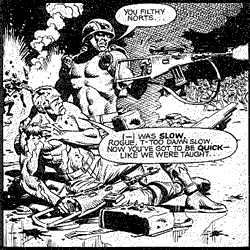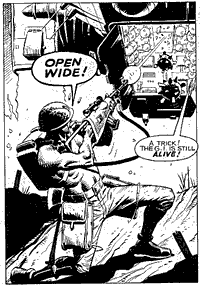>> The Friday Review: The Tale Of One Bad Rat
>> The Friday Review: Cathedral Child
More...

 Writer: Gerry Finley-Day
Writer: Gerry Finley-Day
Artists: Dave Gibbons, Cam Kennedy, Colin Wilson, Brett Ewins & Eric Bradbury
Price: £10.99
Publisher: Titan Books
ISBN: 1-84023-481-4
Back in 1981, 2000AD was approaching it's fifth birthday as an established part of the UK publishing landscape with an impressive array of recognisable SF characters such as JUDGE DREDD and STRONTIUM DOG. But one thing lacking amid the future lawmen, dinosaur farmers, robot disaster squads and mutant bounty hunters was a successful futuristic take on the traditional British comics staple, the war story. Something closer to the traditions of CHARLEY'S WAR than DAN DARE.
2000AD's only previous attempt at this type of story had been THE VC's, a basic but well-received story of space-borne warfare. Given this, VC's writer Gerry Finley-Day was teamed with Dave Gibbons ("WATCHMEN") to create a character concept that would bring the war story back down to ground level.
ROGUE TROOPER features a future conflict with two human factions (Norts and Southers) fighting over the strategic planet of Nu-Earth. Widespread chemical warfare has rendered the environment lethally poisonous, with troops on both sides stumbling across the battlefield dressed in cumbersome chem-suits like medieval knights in armour. The Souther Genetic Infantrymen - genetically engineered to thrive in the toxic wonderland of Nu-Earth - should have yielded a strategic advantage. However, betrayed by a self-serving Souther General, they're massacred, and the position of stalemate restored.
In the aftermath, a battlefield legend emerges of a single surviving GI, the Rogue Trooper. While the war continues around him, he follows his own path in pursuit of the traitor General, seeking vengeance for his slaughtered comrades.
As with a lot of the best 2000AD work, there's an edge of social comment, a "War Is Hell" message alongside the action. It's no coincidence that the manufactured-to-fight Genetic Infantrymen share an acronym with the American "General Issue" servicemen from WWII, the dehumanising label reflecting the view of soldiers as interchangeable components in the larger war machine.
 Despite war itself being the "villain" of the piece, Finlay-Day recognises the need to give the reader a side to root for. While neither protagonist army is portrayed particularly sympathetically, the Souther troops are definitely more fully realised. Fear, anger and confusion are visible through their chemsuit faceplates, while the Norts are largely reduced to a faceless mass of killers behind their opaque gasmasks. Occasional interjections of "Nortspeak" are also evocative of both German and Russian, familiar to the 80s readership as adversaries from the stories of WWII and the Cold War.
Despite war itself being the "villain" of the piece, Finlay-Day recognises the need to give the reader a side to root for. While neither protagonist army is portrayed particularly sympathetically, the Souther troops are definitely more fully realised. Fear, anger and confusion are visible through their chemsuit faceplates, while the Norts are largely reduced to a faceless mass of killers behind their opaque gasmasks. Occasional interjections of "Nortspeak" are also evocative of both German and Russian, familiar to the 80s readership as adversaries from the stories of WWII and the Cold War.
A trademark component of the ROGUE TROOPER concept is the imaginative depiction of exotic future technology, from giant "Dreamweaver" tanks with their hallucinogenic gas weapons, down to daggers with vibrating blades for ripping through chemsuits. But the key piece of future-tech that both makes Rogue the character so memorable, and shapes the way that ROGUE TROOPER the story unfolds, is the bio-chip.
The idea is that a GIs' accumulated combat experience is too valuable a commodity to throw away lightly. So, if mortally wounded, a GI's personality is downloaded onto a semi-organic computer chip. These can be kept powered up in slots on another GI's equipment until a replacement clone body can be provided. This further reinforces the theme of military dehumanisation, with troopers reduced to their bio-chips becoming weapon components physically as well as metaphorically.
This gimmick allowed ROGUE TROOPER to use elements from two classic types of 2000AD story. Firstly, there was Rogue as the last of his kind, the final GI stalking Nu-Earth on a mission of vengeance. And with the biochips having voice synthesizers and being able to partially control their host items, ROGUE TROOPER also functions as a buddy-buddy team story.
The challenge, then, was to construct believable and distinct personalities for Rogue's three bio-chipped companions. Trooper Gunnar - having become one with Rogue's rifle - identifies with the killing process rather too much and develops a psychopathic aspect to his personality. Bagman functions as quartermaster, dispensing equipment from the backpack into which he's installed. In danger of lumbering himself with a deus ex machina character, Finlay-Day introduces a flaw in the shape of a dementia induced by a battle-damaged chip. Finally there is Helm, the bio-chipped helmet, whose inherent limitations as a protaginst are acknowledged in the character's constant doubts about his usefulness to Team Rogue.
 The bio-chip personalities are firmly established by the end of FUTURE WAR, both adding dramatic tension to the story and acting as catalysts for character development. The volume even closes on two stories with Bagman and Helm as their focal characters. This seems a little more forced than originally intended, as they were originally published more than six months apart as bookends to the epic "All Hell On The Dix-1 Front" story that presumably didn't fit within the page count.
The bio-chip personalities are firmly established by the end of FUTURE WAR, both adding dramatic tension to the story and acting as catalysts for character development. The volume even closes on two stories with Bagman and Helm as their focal characters. This seems a little more forced than originally intended, as they were originally published more than six months apart as bookends to the epic "All Hell On The Dix-1 Front" story that presumably didn't fit within the page count.
But despite the high-tech weaponry, ROGUE TROOPER works best when concentrating on the grim nature of war, the horror that's independent of whether fighting with swords and shields, or laser knives and semi-sentient assault rifles. This is most evident in a standout sequence where Rogue encounters two former friends drastically changed by the war. One has become a cold-blooded psychopath, while the other can no longer see why they're fighting. These opposing viewpoints throw them into inevitable conflict, and Rogue can only bear witness to the tragic outcome.
Indeed, the only real failure among the stories in FUTURE WAR is a sub-TRON story set in a computer controlled city. As Bagman and Helm are transplanted from the nightmarish Nu-Earth environment into a sterile virtual world, any elements with which the reader can identify are removed.
FUTURE WAR contains artwork from several different artists. The first half of the book is largely by co-creator Dave Gibbons, and definitely shows signs of the design aesthetic he later used on THE ADVENTURES OF MARTHA WASHINGTON, especially in the giant tanks and chemical warfare suits.
The fine-lined Central European style of Colin Wilson and the grittier Cam Kennedy both add something to the concept without disturbing the visual continuity, and there's also a stylish cameo from Brett Ewins prior to his co- creating another classic 2000AD future war strip, BAD COMPANY.
Like many of the best 2000AD stories, ROGUE TROOPER has a strong anti-establishment stance and a hard satirical edge, but without losing sight of the need to wrap these in a compelling and exciting action-oriented story. While the storytelling is sometimes a little simplistic by today's standards, and occasionally disjointed due to the episodic nature, FUTURE WAR is an enjoyable look at the birth of one of greatest character concepts in the history of the self-styled "Galaxy's Greatest Comic".

This article is Ideological Freeware. The author grants permission for its reproduction and redistribution by private individuals on condition that the author and source of the article are clearly shown, no charge is made, and the whole article is reproduced intact, including this notice.


